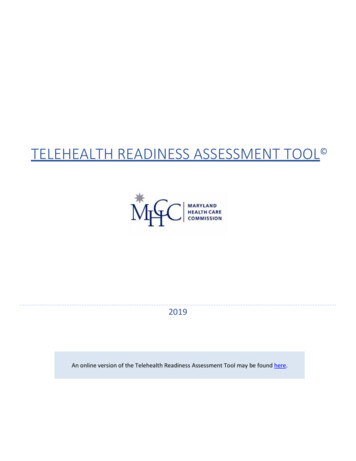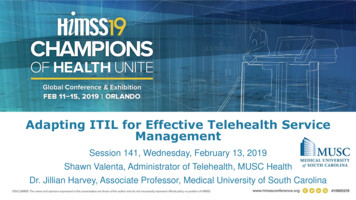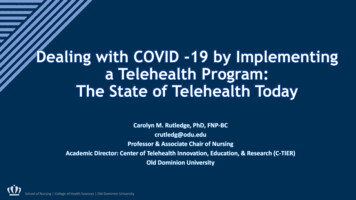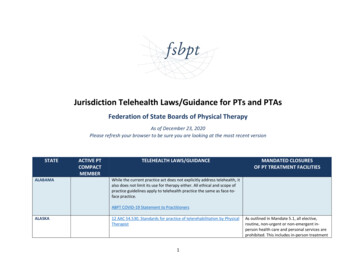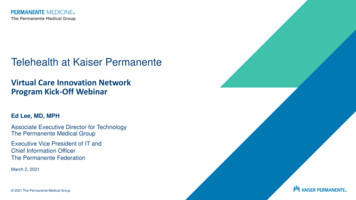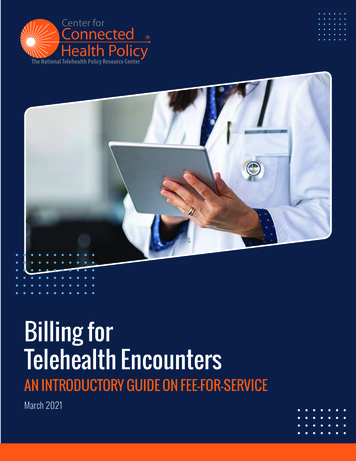
Transcription
Billing forTelehealth EncountersAN INTRODUCTORY GUIDE ON FEE-FOR-SERVICEMarch 2021
INTRODUCTION The COVID-19 Public Health Emergency (PHE) was declaredon January 31, 2020, but it was not until March 30 that CMSbegan to issue temporary telehealth policy, coding and billingguidelines, almost on a weekly basis. These changes complicated– and still complicate - billing for telehealth services due to theirfrequency and the many changes they were enacting, some madepermanent, many still temporary.As it did last year, the Center for Connected Health Policy (CCHP)is providing this informational billing guide to assist those whohave questions regarding telehealth billing. The guide is primarilyabout Medicare fee-for-service billing as policies vary from stateto-state for Medicaid and commercial payers. The purpose of theguide is to clarify: telehealth billing and how to get reimbursed current legislation dictating billing requirements requirements applicable during calendar year 2021 the requirements relevant only during the periods of PHEextensions what may occur post-PHEWith that in mind, this guide is meant not only for those whoare new to Medicare telehealth billing, but for intermediate andveteran telehealth providers and staff who may find this guideuseful: to validate, challenge and perhaps be inspired to take onservices that seem initially too confusing to tackle. The guide’ssecondary purpose is to separate what the Center for Medicareand Medicaid Services (CMS) terms “telehealth”1 and whattele-modalities are “Communication Technology Based Services(CTBS).” Knowing the difference can assist you in making choicesfor short- and long-term practice planning.TOPICS COVEREDIN THIS DOCUMENTPart 1: Common Billing andRegulatory Terms.3Originating Site. 4Distant Site . 5Eligible Providers. 6Codes to Describe Services Provided.7Modifiers.8Place of Service Codes.10Revenue Codes.14Evaluation and Management CPT Codes.15Part 2: Medical Services. 15Other E/M Services.16Non-Telehealth Technology Services.16Remote Physiologic Monitoring (RPM).18eConsult or InterprofessionalConsultation Codes.20Other . 311) Center for Medicare and Medicaid Services, MLN Booklet: Telehealth Services, March 2020. ealthSrvcsfctsht.pdf (Accessed January 28, 2021). Public Health Institute/Center for Connected Health Policy 2021
BILLING FOR TELEHEALTH ENCOUNTERSAn Introductory Guide on Fee-for-ServicePAGE 3Introduction (cont.)Color Guide for BoxesThe guide will list the permanent Medicare policy and call-out boxes willhighlight temporary expansions in place during the PHE. As each state’sMedicaid telehealth reimbursement policies vary, we are using California forthe Medicaid example, and these tips should assist in researching your ownstate’s Medicaid policies. Please note, at the time this guide is being written,proposals have been made that could impact California’s Medicaid policies.As with all policies listed in this guide, changes can be made at any time.Therefore, it is suggested that you check the CCHP website for any updatedinformation. In addition, you can find your own state Medicaid telehealthpolicies on CCHP’s website at www.cchpca.org.Medicare PHE/FederalMedicare PermanentMedicaid/CaliforniaGeneral billing tipsRemindersBecause the discussion will focus on Medicare, “Fee for Service” (FFS)2 is highlighted and the guide will notget into specifics about commercial plans, although it is important to know that some follow CMS’ policies.Managed care plans, private payers and employer-based plans also generally follow CMS’ rules but be sure tocheck with the plan. Payment is not guaranteed for every visit, whether due to frequency limitations, diagnosiscode or extent of coverage afforded by the plan. (For more detailed information on California government andcommercial billing, please visit the California Telehealth Resource Center’s website at www.caltrc.org.) Finally,please know that this CCHP resource is only provided as a guide and should not be considered legal advice nora guarantee of reimbursement.Part 1: Common Billing and Regulatory TermsUnderstanding general billing and telehealth terminology when put into context will help answer questionsyou, your providers and patients may have about reimbursement for services. The questions may include: How do I bill for telehealth and get paid? What are my state’s regulations? How is my state’s Medicaid plan different from Medicare’s terms? Does my patient have a co-pay?TERMINOLOGYTelehealth DefinitionsTelehealth definitions vary on the federal, state and individual payer level. The scope of the following termsdiffer between Medicare and Medicaid plans, and you may have to modify your claims, whether billed via theCMS 1500 (professional fee claim form), or the UB-04 (facility fee claim form) based on the payor.2) HealthCare.Gov, “Fee for Service,” e/ (Accessed January 28, 2021). Public Health Institute/Center for Connected Health Policy 2021
BILLING FOR TELEHEALTH ENCOUNTERSAn Introductory Guide on Fee-for-ServicePAGE 4Part 1: Common Billing and Regulatory Terms (cont.)PHE EXCEPTION: MEDICAREDuring the PHE, the patient’s home canserve an originating site, in addition to thesites originally specified.ORIGINATING SITEThe originating site is where the patient is located when thetelehealth interaction takes place. In Medicare, it is limited bothgeographically and by the specific site a patient is located in at thetime of the telehealth interaction (home, doctor’s office, school,etc.). Under the usual Medicare policy, the beneficiary must belocated in: A county outside a Metropolitan Statistical Area (MSA); A Rural Health Professional Shortage Area (HPSA) in a ruralcensus tract; or From an entity that participates in a federal telemedicinedemonstration project approved by the Secretary of HHS as ofDec. 31, 2000; and Be in a specific eligible site (Figure 1)The Health Resources and Services Administration (HRSA) decidesHPSAs, and the Census Bureau decides MSAs. To see an originatingsite’s potential payment eligibility, go to HRSA’s Medicare TelehealthPayment Eligibility Analyzer.3 There are some exceptions to the ruralrequirement for the treatment of end state renal disease, acutestroke and substance use disorder (SUD). See Figure 1.NEW!!! PERMANENT ORIGINATING SITE CHANGESDue to the passing of the Consolidated Appropriations Act of 2021 (theAct 2021), in December 2020, Figure 1 undoubtedly will be updated toinclude Rural Emergency Hospitals (new designation, see Place of Servicesection below) and for mental health patients in the home, requiring anin-clinic visit 6 months prior to the home encounter.*( hr133enr.pdf )PHE EXCEPTION: MEDICAREBecause the patient’s home can serve an originating site, a clinic orfacility can bill Q3014.(Covid-19 FAQs: 19-faqs-508.pdf)3) Telehealth Payment Eligibility Analyzer, https://data.hrsa.gov/tools/medicare/telehealth (Accessed January 29, 2021) Public Health Institute/Center for Connected Health Policy 2021Covid-19 FAQs, located here: 19-faqs-508.pdfFigure 1Medicare Originating Sites(Some are allowable only for certain conditions) Physician and practitioner offices Hospitals Critical Access Hospitals (CAHs) Rural Health Clinics Federally Qualified Health Centers Hospital-based or CAH-based RenalDialysis Centers (including satellites) Skilled Nursing Facilities (SNFs) Community Mental Health Centers(CMHCs) Renal Dialysis Facilities* Homes of beneficiaries with End-StageRenal Disease (ESRD) getting homedialysis* Mobile Stroke Units* Home of Patient receiving treatmentfor SUD/Opioid Abuse and cooccurring mental health disorders** Geographic limit may not apply to these facilities in specificcircumstances.NOTE: Geographic limitations on originating site removed fortreatment & diagnosis of acute stroke.BILLING TIP!Note that an originating site maybill Medicare a facility fee usingcode Q3014. If the originating siteis the home, no facilityfee may be billed
BILLING FOR TELEHEALTH ENCOUNTERSAn Introductory Guide on Fee-for-ServicePAGE 5Part 1: Common Billing and Regulatory Terms (cont)WHAT ABOUT ATAN RHC OR FQHC?Medicaid Example: California“Originating site” means the place where a patient is located at the timehealth care services are provided via a telecommunications system or wherethe asynchronous store and forward service originates. For purposes ofreimbursement for covered treatment or services provided through telehealth,the type of setting where services are provided for the patient or by the healthcare provider is not limited (California Welfare and Institutions Code [CA W&ICode], Section 14132.72[e]). The type of setting may include, but is not limitedto, a hospital, medical office, community clinic or the patient’s home.Source: California Department of Health Care Services, Medi-Cal Provider Manual: /masters-MTP/Part2/mednetele.pdf, accessed January 28, 2021.Section 1834(m) (4) (C) (ii) ofthe Act authorizes RHCs andFQHCs to serve as telehealth“originating sites” (where thepatient is located) for qualifiedtelehealth services in Medicare.FQHCs/RHCs may bill the Q3014facility fee, however, Section1834(m) (1) of the Act, whichdescribes eligible distant siteproviders, does not includeRHCs and FQHCs.DISTANT SITEMedicare does not define “distant site” locations; however, providers cannot be physically located out ofthe United States when providing the telehealth services.4PHE EXCEPTION: MEDICAREFQHCs and RHCs were added to the eligible list of who mayserve as distant site providers. However, FQHCs and RHCs willnot be paid their typical prospective payment system (PPS)or “all inclusive rate” (AIR). While these entities may provideservices via telehealth under Medicare, they will be paid 92.03for each eligible service delivered via telehealth, all of which arebilled using HCPCs code G2025.This amount is based on a formula created by CMS -19-faqs-508.pdf ) (Accessed January 28, 2021).TRY IT!Click on CCHP’s site, here, to find your state. Compare your state’spolicy definitions to Medicare’s: What is the same? What is different?Medicaid Example: California“Medi-Cal defines the “distant site” as “.a site where a health care provider whoprovides health care services is locatedwhile providing these services via atelecommunications system. The distantsite for purposes of telehealth can bedifferent from the administrative location.”This allows the practitioner to be in alocation suitable to telehealth encounters,but not necessarily in a clinic or facilitythemselves.Source: California Department of Health CareServices, Medi-Cal Provider Manual: ublications/masters-MTP/Part2/mednetele.pdf (Accessed January29, 2021).4) Section 1862(a)(4) of the Social Security Act and 42 CFR § 411.9(a). Public Health Institute/Center for Connected Health Policy 2021
BILLING FOR TELEHEALTH ENCOUNTERSAn Introductory Guide on Fee-for-ServicePAGE 6PHE EXCEPTION: MEDICAREProvider-Based and Facility ClinicsA provider may be at home and provide services. However, there is a difference in the originating site payment dependingon whether the provider is home or “on site”. Because the originating site requirement is waived during the PHE, the provider may bill for the originating site feewhen the patient is at home. The “Hospital Without Walls” allows:o Provider and Patient at home: bill Q3014o For facility-based (i.e., those who “split bill”): Provider on site and patient at home: bill G0463 (facility feeassociated with evaluation and management services) not considered ‘telehealth’ as the facility wall has extended to the patients’ homes, as long as provideris on site Expansion of Hospitals Without Walls for Inpatient Serviceso During this COVID-19 surge, CMS also has expanded payment to extend to a patient’s home while stilladmitted as inpatiento The provider may see the patient via telehealth, but this would be billed as if the patient were at the facility(no modifier)o RN visits to the patients’ homes are part of the ital-capacity-amid-covid-19-surge(Accessed January 29, 2021).ELIGIBLE PROVIDERSMedicare limits the type of provider who canprovide a service. Those providers include: Physicians Nurse practitioners (NPs) Physician assistants (PAs) Nurse-midwives Clinical nurse specialists (CNSs) Certified registered nurse anesthetists Clinical psychologists (CPs) and clinical socialworkers (CSWs)5 Registered dietitians or nutrition professionalsMedicaid Example: CaliforniaMedi-Cal does not limit the type of provider who mayprovide services via telehealth. However, FQHCs andRHCs do face certain limitations.REMINDERFlexibilities during the PHE regarding cross-statelicensing can be viewed on the Federation of StateMedical Board’s site: .pdf(Accessed January 29, 2021)PHE EXCEPTION: MEDICARE“The waiver of these requirements expands the types of health care professionals that can furnish distant sitetelehealth services to include all those that are eligible to bill Medicare for their professional services. This allowshealth care professionals who were previously ineligible to furnish and bill for Medicare telehealth services, includingphysical therapists, occupational therapists, speech language pathologists, and others, to receive payment forMedicare telehealth mary-covid-19-emergency-declaration-waivers.pdf (Accessed January 29, 2021).5) CPs and CSWs cannot bill Medicare for psychiatric diagnostic interview examinations with medical services or medical evaluation and management services. They cannot bill or get paidfor Current Procedural Terminology (CPT) codes 90792, 90833, 90836, and 90838. Public Health Institute/Center for Connected Health Policy 2021
BILLING FOR TELEHEALTH ENCOUNTERSAn Introductory Guide on Fee-for-ServicePart 1: Common Billing and Regulatory Terms (cont)PAGE 7CODESCODES TO DESCRIBE SERVICES PROVIDEDA brief overview of Common Procedural Terminology (CPT) codes would help any billing discussion, and understandhow CMS, Medicaid, other payors and coders and billers discuss coverage. Note that CPTs can go on the CMS 1500or the UB-04. For those new to billing, a CPT or “Common Procedural Terminology” code is defined by the AmericanMedical Association (AMA) as follows6:a uniform language for coding medical services and procedures All CPT codes are five-digits and can beeither numeric or alphanumeric, depending on the category.Category I: These codes have descriptors that correspond to a procedure or service. Codes range from00100–99499 and are generally ordered into sub-categories based on procedure/service type and anatomy.Category II: These alphanumeric tracking codes are supplemental codes used for performance measurement.Using them is optional and not required for correct coding.Category III: These are temporary alphanumeric codes for new and developing technology, procedures andservices. They were created for data collection, assessment and in some instances, payment of new servicesand procedures that currently don’t meet the criteria for a Category I code.CMS groups CPT codes for different programs and this is how CMS categorizes eligible services that may be provided viatelehealth. CMS maintains a Telehealth CPT Code list7 which grew from 103 CPT codes at the start of 2020 to 252 codesat the beginning of 2021. Of the 252 on this list, 9 codes added during the PHE are now permanent, and additionalcodes were placed in a temporary category per the below (Category 3).Process to Request Services for Telehealth CPT ListTo request a service be added to the approved telehealth CPT list, CMS assigns the requests into three “categories.”8Category 1: Services that are similar to professional consultations, office visits, and office psychiatry servicesthat are currently on the list of telehealth services.Category 2: Services that are not similar to the current list of telehealth services. Review of these requestswill include an assessment of whether the service is accurately described by the corresponding codewhen delivered via telehealth and whether the use of a telecommunications system to deliver the serviceproduces demonstrated clinical benefit to the patient.Category 3 NEW IN 2020, for the PHE: Services that are likely to provide clinical benefit via telehealthyet lack sufficient clinical evidence to evaluate making them permanent under Category 1 or Category 2,above. These are to remain in effect until the end of the calendar year in which the PHE ends (not whenthe PHE ends).Note that the originating site and provider expansions will not remain during that time period.6) American Medical Association, “CPT overview and code gement/cpt/cpt-overview-and-code-approval (Accessed January 29, 2021).7) Center for Medicare and Medicaid Services, “List of Telehealth Services,” rmation/Telehealth/Telehealth-Codes (Accessed January 29, 2021Updated January 14, 2021).8) Center for Medicare and Medicaid Services, “CMS Criteria for Submitted Requests,” rmation/Telehealth/Criteria (Accessed January 29, 2021). Public Health Institute/Center for Connected Health Policy 2021
BILLING FOR TELEHEALTH ENCOUNTERSAn Introductory Guide on Fee-for-ServicePAGE 8Part 1: Common Billing and Regulatory Terms (cont)TRY IT!Review the codes on the list: 96161 – Permanent code on the list 99477 – Temporary during the PHE 99476, 99478, 99479 and 99480 – Category 3 codes after the PHE is over and the patient is in an HRSA-eligible geographic location at an eligible originating site, 99476 will be reimbursedthrough the end of CY202X. It will not be reimbursed the following calendar year, unless evidence collected confirms eligibility. At that time,then, it will be moved over to permanent status.MODIFIERSLike CPT codes, a brief overview of modifiers will help to clarify questions regarding their usage for telehealthservices. Billing examples showing how they are used are located at the end of the guide.According to Noridian, the Jurisdiction E Medicare Administrative Carrier (MAC), modifiers9 are: two-digit numbers, two-character modifiers, or alpha-numeric indicators. Modifiers provide additionalinformation to payers to make sure your provider gets paid correctly for services rendered. more than one modifier may be used with a single procedure code; however, they are not applicable forevery category of the CPT codes. Some modifiers can only be used with a particular category and someare not compatible with others.9) Noridian Health Care Solutions, Modifiers, difiers (Accessed January 29, 2021). Public Health Institute/Center for Connected Health Policy 2021
BILLING FOR TELEHEALTH ENCOUNTERSAn Introductory Guide on Fee-for-ServicePart 1: Common Billing and Regulatory Terms (cont)PAGE 9For Medicare telehealth claims, the CPT modifiers listed below are used for particular situations: G0 (zero): Used to identify telehealth services furnished for purposes of diagnosis, evaluation, or treatment ofsymptoms of an acute stroke. GQ (not used unless you are in Alaska or Hawaii): asynchronous telehealth service. GT: Critical Access Hospital distant site providers billing under CAH Optional Method II. This goes on aninstitutional claim and pays 80% of the Professional Fee Service rate. GY: Notice of Liability Not Issued, Not Required Under Payer Policy. Used to report that an Advanced BeneficiaryNotice (ABN) was not issued because item or service is statutorily excluded or does not meet definition of anyMedicare benefit. (Note: only to be used when the patient is not at an eligible originating site.)Managed care and private plan policies vary on what modifier they require in order to bill for telehealth (GT or 95).Always check with the plan to see what is required for your billing.PHE EXCEPTION: MEDICAREDuring the PHE, the CPT codes representing telehealth services require a modifier 95 (telehealth) to be placed on the CMS1500 in order to differentiate between telehealth and on-site services. This is because the regular Place of Service (POS)code is indicated to ensure a higher rate of reimbursement to partially offset reimbursement losses incurred when patientscannot come into an office or hospital outpatient department clinic.Medicaid Example: CaliforniaFor Medi-Cal, the modifiers for telehealth are as follows:Synchronous, Interactive Audio and Telecommunication Systems: Modifier 95Modifier 95 must be used for Medi-Cal covered benefits or services delivered via synchronous, interactive audio/visualtelecommunications systems. Only the portion(s) of the telehealth service rendered at the distant site are billed withmodifier 95. The use of modifier 95 does not alter reimbursement for the CPT or HCPCS code.Asynchronous Store-and-Forward Telecommunication Systems: Modifier GQModifier GQ must be used for Medi-Cal covered benefits or services including, but not limited to, teleophthalmology,teledermatology, teledentistry and teleradiology, delivered via asynchronous store-and-forward telecommunicationssystems, including e-consult (CPT 99451). Only the service(s) rendered from the distant site must be billed with modifier GQ.The use of modifier GQ does not alter reimbursement for the CPT or HCPCS code billed.Source: California Department of Health Care Services, Medi-Cal Provider Manual: Telehealth s/mastersMTP/Part2/mednetele.pdf (Accessed January 29, 2021). Public Health Institute/Center for Connected Health Policy 2021
BILLING FOR TELEHEALTH ENCOUNTERSAn Introductory Guide on Fee-for-ServicePAGE 10Part 1: Common Billing and Regulatory Terms (cont)BILLING TIP!REMINDERWhat about cost sharing or a co-pay during the PHE?Medicare is allowing providers to reduce or eliminate costsharing for telehealth visits during the PHE, see the March 17,2020 news bulletin here.If a provider or a facility staff memberprovide a telehealth visit to a Medicarebeneficiary that did not meet the statutoryguidelines (ineligible originating site, forexample), put a GY modifier on the CPT(on either the CMS 1500 or UB-04)to indicate that you providedan excluded service.PLACE OF SERVICE CODESCMS publishes a Place of Service (POS) code list10 that tells CMS via the CMS-1500 where the provider andpatient are located during a health encounter. The treatment location affects reimbursement, the CPT codecategories and sometimes the modifiers to use with the CPT codes. What follows are codes specific to telehealthservices.Synchronous Services POS CodeFor Medicare synchronous telehealth services, a POS 02 (telehealth) must go on the CMS 1500. The addressindicates the geographic factor CMS calculates into the payment rate for accurate reimbursement. Noridianstated that when a provider assigns their enrollment rights to a group or facility, then the group address is whatis indicated on the CMS 1500, with the practitioner’s address known to CMS (if working a large portion of time athome), but billed through the group entity.11DOES MY PATIENT HAVE TO PAY A CO-PAY?Medicare requires cost-sharing for all services so consent must be obtained but can be done by staff and at a non-specifictime (not necessary at time service performed). Since the provider work is done either via audio or not necessarily face toface with the patient, it’s a good idea for either you or your staff to educate patients about the services, so they are notsurprised about receiving a bill for their plan’s deductible amount or co-pay.10) Center for Medicare and Medicaid Services, Place of Service Code Set, ce-codes/Place of Service Code Set.html. (AccessedJanuary 24, 2021).11) Noridian Health Care Solutions, Telehealth/Telemedicine Enrollment, t/complex-specialties/telehealth (Accessed Jan 24, 2021). Public Health Institute/Center for Connected Health Policy 2021
BILLING FOR TELEHEALTH ENCOUNTERSAn Introductory Guide on Fee-for-ServicePAGE 11Part 1: Common Billing and Regulatory Terms (cont)PHE EXCEPTION: MEDICARECMS is paying providers the fee they would have received had their patients physically come into a non-facility/provider based or facility-based clinic. Note that prior to the PHE, non-facility clinics received only the facility-basedreimbursement for its distant site provider services (the originating site collecting the facility fee in billing Q3014 andreceives 27).During the PHE, non-facility clinics indicate POS 11 (using a modifier 95 on the CPT billed) and receive 100%reimbursement.To offset the loss of a facility fee which is not paid for telehealth encounters (as the patient is not coming on site), duringthe PHE, CMS instructs facility-based clinics to use POS 19 or 22 (with a modifier 95 on the CPT billed). Depending onwhere their provider is located at the time of the telehealth encounter, the facility can: receive the facility-based professional fee, plus either an originating site fee (Q3014) if the provider is off campus(typically, home) or if on site, the facility evaluation and management fee (G0463-PN)Medicaid Example: CaliforniaMedi-Cal’s address requirement for telehealth claims:“The distant site for purposes of telehealth can be differentfrom the administrative location.” An interpretation of thisstatement, based on the above discussion, would indicatethat under POS 02, the address for Box 32 means thepractitioner’s “usual” place of business.Asynchronous Services 12Medi-Cal does not have any geographic limitations. Bill with a GQmodifier. As noted earlier, asynchronous services are not reimbursed inMedicare outside of Alaska and Hawaii.BILLING TIP!When an MD located in a provider-based clinicbills CMS for a telehealth encounter with anestablished patient at an eligible originatingsite, the codes used could potentially be:99214, POS 02 (telehealth). Because thepatient is not at the clinic, the non-facility – orprovider owned clinic - is reimbursed at thefacility provider rate, which is lessthan a provider-based,in-clinic visit.The Full Set of POS CodesCan you describe your place of work in two numbers? If so, you must be a coder/biller. If not or if you are askedto bill for a different type of facility, a succinct listing of practice types is provided by CMS on its website. Thereare descriptions that describe the practice and what code to put on the bill. The following describes a few of thesettings that people regularly ask about in terms of billing.12) California Department of Health Care Services, Medi-Cal Provider Manual, Medicine: Telehealth. s/masters-MTP/Part2/mednetele.pdf(Accessed January 28, 2021). Public Health Institute/Center for Connected Health Policy 2021
BILLING FOR TELEHEALTH ENCOUNTERSAn Introductory Guide on Fee-for-ServicePAGE 12Part 1: Common Billing and Regulatory Terms (cont) Independent Clinic (POS 49): A clinic that is not part of a hospital and is for outpatient treatment. Theemployees in this type of practice will be able to act under general or direct supervision of the treatingpractitioner who is managing patient care. This means incident-to billing can occur, which has an impacton the remote patient monitoring (RPM) codes. This also affects whether or not certain Chronic CareManagement (CCM)13 services can be billed. This can be an originating site for Medicare services if eligibleunder HRSA guidelines, as well as a distant site. Note that Remote Physiological Monitoring and CCM donot fall under geographic restrictions, as they are not “telehealth.” Off Campus Outpatient Hospital Clinic (POS 19): This type of clinicemploys staff who do not have a direct employment relationship withthe ordering physicians. Thus, any activities performed under the director general supervision of the physician are bundled with the facilityservices on the UB-04 and cannot be reported on the CMS 1500 orbilled under the physician’s NPI.14A portion of an off-campus hospital provider-based departmentwhich provides diagnostic, therapeutic (both surgical andnonsurgical), and rehabilitation services to sick or injured persons whodo not require hospitalization or institutionalization. (Effective January1, 2016.)15POS 19 can be an originating site for Medicareservices if eligible under geographic requirements,as well as serve as a distant site location for aprovider. Inpatient service (POS 21): This can be
the Medicaid example, and these tips should assist in researching your own state’s Medicaid policies. Please note, at the time this guide is being written, proposals have been made that could impact Califor
